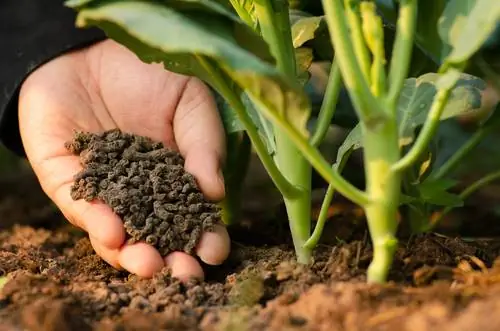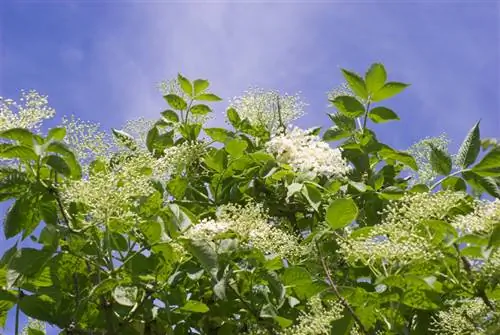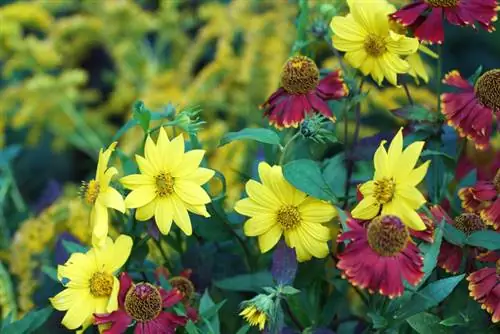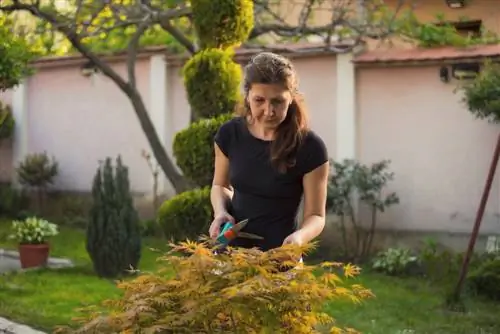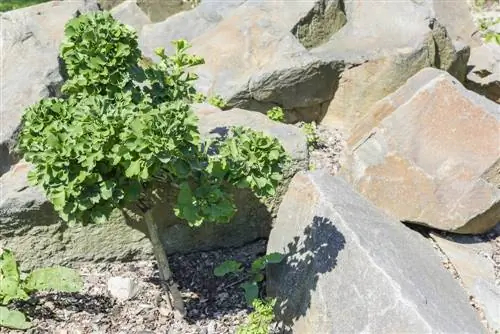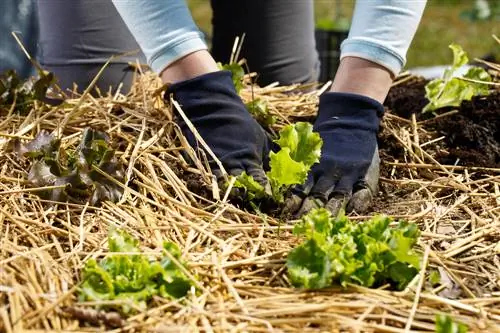- Author admin [email protected].
- Public 2023-12-16 16:46.
- Last modified 2025-01-23 11:22.
Hobby gardeners often notice that the soil is not optimally supplied with nutrients due to the deficiency symptoms in their plants. They administer fertilizers and often do not realize that they are causing more harm than good with careless fertilization.

How do you fertilize plants efficiently and correctly?
To fertilize plants efficiently, you should spread 3 liters of compost per square meter in spring, take the pH of the soil into account and use organic fertilizers such as compost, horse manure or coffee grounds. Fertilize in the morning and pay attention to the nutrient requirements of the respective plants.
What nutrients do plants need?
For he althy growth, plants need nutrients and trace elements. These are naturally present in the soil, although the composition can vary depending on the type of soil. The vitality of a plant is influenced by the nutrient that is present at its minimum. If the concentration of a substance is too low, deficiency symptoms occur.
| Symbol | Meaning | |
|---|---|---|
| Phosphorus | P | serves for flower, seed and fruit development |
| Nitrogen | N | promotes the formation of chlorophyll |
| Potassium | K | ensures water transport and plant stability |
| Magnesium | Mg | supports metabolism and photosynthesis processes |
| Calcium | Ca | important building block of cell walls |
| Iron | Fe | promotes plant growth and fruit yield |
Fertilize efficiently
Proper fertilization is a science in itself, because numerous factors influence the frequency and intensity of the nutrient supply. Heavy eaters need more nutrients than light eaters. A fertilizer recommendation is only possible if the soil has been analyzed beforehand.
How to fertilize correctly:
- Apply three liters of compost per square meter every year in spring
- Refertilize heavy feeders in late spring with horn shavings (€32.00 on Amazon)
- Provide plants on acidic sites with horn shavings once a year
Soil pH value
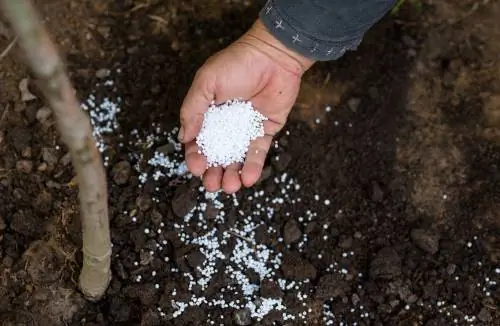
Lime is used for acidic soils
How well the nutrients can be absorbed by the plants depends on the pH value of the soil. This describes the acidity and can be in the acidic, neutral or basic range. The majority of all cultivated garden soils are slightly acidic and have a pH value of 6.0. Most plants prefer this value.
The pH value can be increased by adding lime. The substrate becomes loose and microorganisms make nutrients available to plants. It is enough to lime every three to four years. Otherwise there is a risk that the soil will leach out. If the substrate is too basic, it can be mixed with ericaceous soil.
Soil type
Basically, a distinction is made between light, medium and heavy soils. The soils in Central Germany are predominantly heavy because they contain clay. Heavy substrates can store nutrients better than sandy soils, which predominate in northern Germany. They therefore need to be fertilized less often, while sandy soils require more frequent nutrient supply. These can be improved with green manure or compost.
Fertilization tailored to the soil:
- heavy soils: add nitrogen
- medium-heavy soils: fertilize if there are deficiencies
- light soils: improve with compost, green manure or mineral fertilizer
When is the best time to fertilize?
When you need to fertilize your plants depends on the environmental conditions. As soon as the growing season begins and the plants sprout, nutrients are needed. It is ideal if you have already fertilized before budding. Adding fertilizer later is not a problem as long as you follow a few rules:
- fertilize in the morning so that the plant can absorb nutrients with the water throughout the day
- Do not fertilize when it rains as the nutrients will be washed away
- moisten the substrate before adding mineral nutrients so that nutrients can dissolve
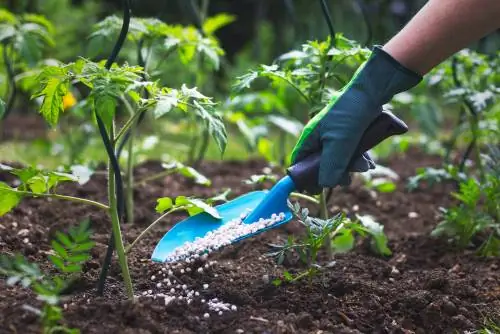
Hungry plants like tomatoes need fertilizer several times
Fertilizing throughout the year
Long-term fertilizers such as horn shavings can be incorporated into the bed in late autumn. They decompose slowly so that the plants are supplied with nutrients in time for budding in spring. Depot fertilizer or granules are added directly to the planting hole so that perennials and trees can draw nutrients directly.
Compost as a universal fertilizer is incorporated into the substrate in spring. This will ensure your plants have an optimal start to the growing season. If you use readily available synthetic fertilizers, you should use them when necessary.
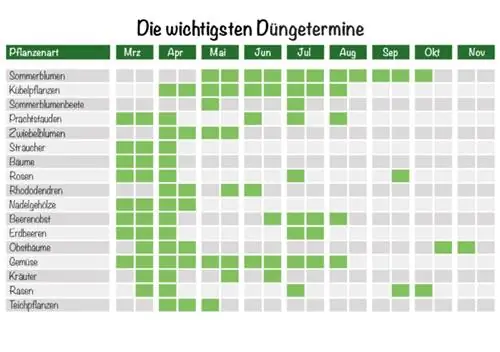
- fertilize only in the growth phase between March and August
- Use mineral fertilizers containing nitrogen only between the end of March and July
- Administer potassium-rich fertilizers in late summer
Fertilize organically
Organic fertilizers are an ecological alternative to artificial fertilizers. Agriculture produces by-products that are used as natural nitrogen fertilizer. These release the nutrient slowly as they decompose in the soil over time. This prevents over-fertilization. Compost is an ideal organic complete fertilizer that activates soil life.
Fertilizers with main nutrients:
- Nitrogen: horn shavings, feather or bone meal
- Iron: Plant manure
- Potassium: Sheep's wool pellets
- Phosphorus: rock dust, cattle and horse dung

Horse manure
Horse manure contains a variety of important nutrients and also improves soil vitality. This organic fertilizer is ideal for heavy feeders and can also be used to provide nutrients for lawns, hedges and fruit trees or flower beds. Do not use fresh manure as it may contain seeds of various weeds. In addition, the ammonia content in fresh manure is very high, which negatively affects the quality of the soil. A year of stored manure in which the seeds have been killed by sunlight or hot rot can be safely used for fertilization.
How to use horse manure correctly:
- suitable for tomatoes, pumpkin, zucchini and corn
- about two to four liters of horse manure per square meter
- work in a maximum depth of 30 centimeters
- alternatively mix in the compost
Compost
Countless microorganisms ensure that plant materials are decomposed. In order for the processes to run optimally, both air and moisture are necessary. In an optimal compost, high temperatures are created, which kills weed seeds. Fresh compost is a universal fertilizer that is suitable for almost all plants. However, the nutrients vary greatly depending on the plant material being composted. The nitrogen content is usually between one and two percent.
Excursus
C/N ratio in compost
Microorganisms need nitrogen so that new cells can be formed. The ratio of carbon to nitrogen is crucial for the reproduction of microorganisms. If there is an excess of nitrogen, ammonia is formed. This shifts the pH value into an unfavorable range, which causes further decomposition processes to suffer. Sawdust helps in this case because it has a high proportion of carbon and a low proportion of nitrogen.
Coffee grounds
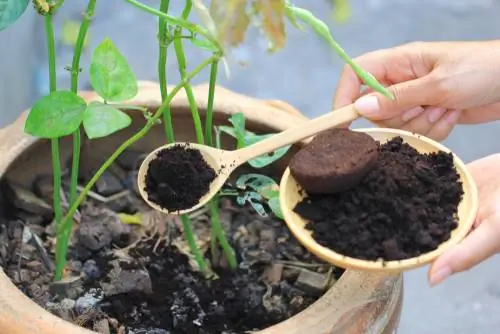
Coffee is often used as a fertilizer, but should be dosed well
Raw coffee beans have a protein content of eleven percent, which is completely broken down by roasting. Humic acids are formed during roasting, which gives coffee grounds a slightly acidic pH value compared to fresh coffee beans. Unroasted beans contain nitrogen, sulfur and phosphorus. These nutrients are largely retained in the degradation products, which is why coffee grounds are ideal as fertilizer.
Fertilize properly with coffee grounds:
- good for hydrangeas, rhododendrons and blueberries
- Work coffee grounds into the bed and then mulch
- When repotting, mix a handful of coffee grounds into the fresh potting soil
Tip
You should fertilize houseplants weekly with half a cup of diluted black coffee. Coffee grounds on the root ball quickly tend to form mold.
Unsuitable fertilizers
Artificially produced fertilizers are highly concentrated and provide the plant with nutrients that do not need to be converted beforehand. They are immediately available to plants. There are artificial fertilizers in liquid or solid form. To ensure that the nutrients are released more slowly, synthetic fertilizer beads are surrounded by a protective cover. The production of such products is very energy-intensive. If the dosage is incorrect, plant growth suffers, so damage is inevitable. In addition, chemical fertilizers affect the environment when they are washed into water bodies.
Why spend a lot of money on artificial fertilizers? These products hardly offer any advantages.
Ashes
Wood ash can be used for liming, but should not be used as regular fertilizer. The pH of pure ash can range from 11.0 to 13.0. Calcium is present in its most aggressive form, quicklime. This can lead to leaf burns and affect soil life, especially in light sandy soils. In agriculture, only unvegetated and very loamy or clayey soils are limed with calcium oxide.
Tip
If you add ash to the compost, you should only light the wood with brushwood, leaves and pieces of bark. Recycled paper may contain residues of mineral oil.
Frequently asked questions
What is horn shavings, horn semolina and horn flour?
Horn shavings are made from shredded cattle hooves, claws and horns. Horn semolina is coarsely ground horn shavings with a grain size of between two and five millimeters. If the grinding degree is less than two millimeters, the product is called horn meal. The finer the grain size, the faster the fertilizer decomposes and becomes available to plants. The decomposition occurs by microorganisms. These fertilizers provide nitrogen and improve the formation of humus in the soil. They can be added to the compost to increase the nitrogen content.
Why is blue grain unsuitable as fertilizer?
This fertilizer was very popular in the garden for a long time because, as a complete mineral fertilizer, Blaukorn contains nitrogen, phosphate and potash in water-soluble form. However, nitrogen is present as water-soluble nitrate, which is largely washed out by rain and can enter the groundwater. These so-called NPK fertilizers do not provide food for soil organisms and impair humus formation. The result of years of using blue grain is an oversupply of phosphate and potassium.
How often should I fertilize?
Statistics from soil laboratories show every year that the soils of private gardens are sometimes heavily over-fertilized. The phosphate content is often extremely high and the potassium content is also too high. According to estimates, 90 percent of all hobby gardeners fertilize based on their instincts without prior soil analysis. By using complete mineral fertilizers or special fertilizers, phosphate and potassium accumulate in excessive amounts. Therefore, it is better to fertilize too little than too much.
Which fertilizer should I choose?
Compost is considered an all-purpose fertilizer that is suitable for almost all plants, especially heavy feeders. Compost is not recommended for plants that prefer acidic soils. These should be better supplied with coffee grounds. Fertilization with cottonseed meal ensures that the pH value remains in the acidic range.

